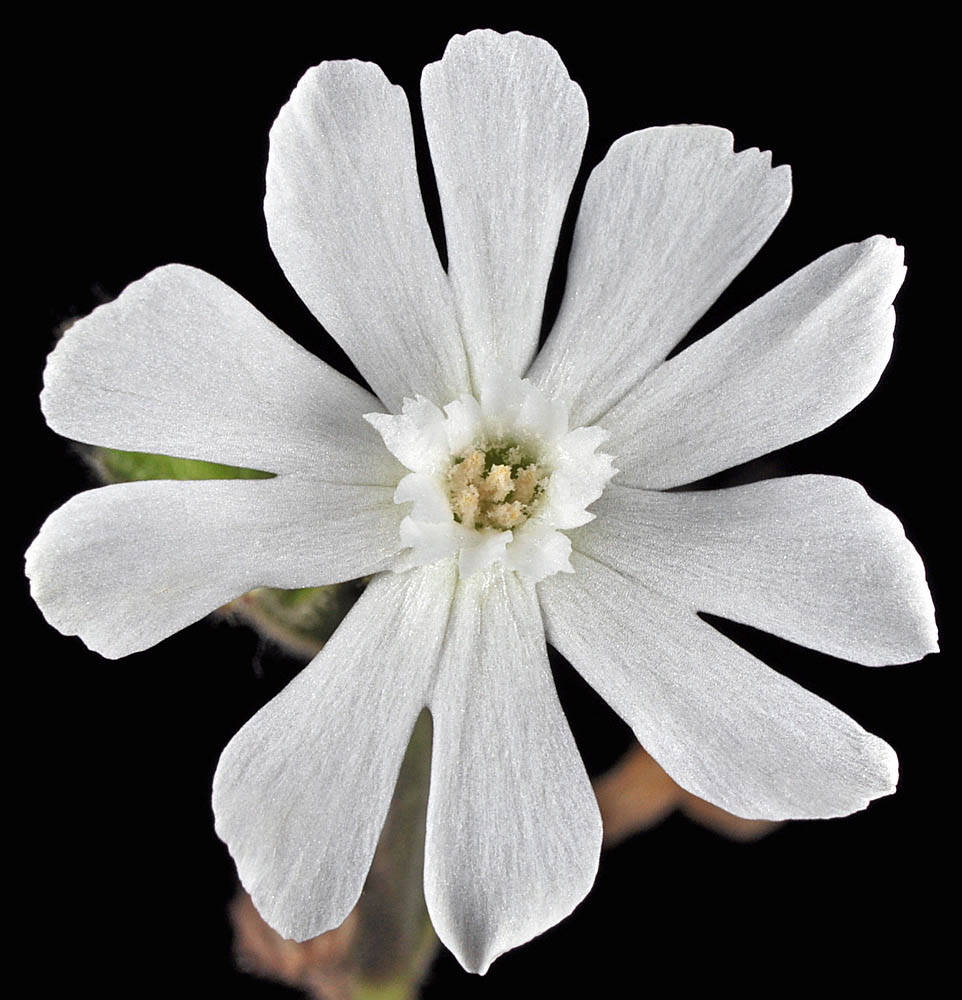
Plants annual, biennial or perennial; taproots and caudices woody.
Stems erect or sometimes decumbent at base, 30–120 cm, branches few, generally hirsute, often glandular above.
Leaves basal often withering; middle cauline oblanceolate to elliptic, 5–14.5 cm × 6–30(56) mm; upper cauline lanceolate to elliptic, 1.5–8 cm × 3–15 mm, gradually reduced upward.
Inflorescences terminal, open cymes, not 1-sided; pedicels sometimes 0 (staminate flowers), glandular puberulent.
Flowers unisexual; ascending to erect; calyces tubular (staminate) or ovoid (pistillate), much inflated in fruit, 12–20 mm, 10-veined (staminate) or 20-veined (pistillate), not netted above, pale commissures present, hirsute-glandular, lobes 3–6 mm, tips obtuse or acuminate; petal claws glabrous; appendages 2; limbs 7–9(12) mm, white, entire or lobes 2; stamens slightly exserted or equaling petal claws; styles 5, slightly exserted.
Fruits ovoid, teeth 5, splitting to 10; stalks 1–2 mm.
Seeds 1–2 mm, gray-brown, not winged.
2n=24.
Disturbed areas, field edges, shaded riverbanks. Flowering May–Sep. 0–1800 m. BW, Casc, CR, ECas, Sisk, WV. CA, ID, WA; throughout North America except far north and southeast; Europe. Exotic.
Silene latifolia is an introduced species that may have arrived via ballast; the first collection in Oregon was made in 1911.
as described under Silene latifolia
Plants annual or short-lived perennial; taproot woody. Stems erect or decumbent at base, branched, to 100 cm, finely hirsute, glandular-puberulent distally. Leaves: blade hirsute on both surfaces; basal usually withering by flowering time, petiolate, blade oblong-lanceolate to elliptic; cauline sessile, reduced into inflorescence, blade lanceolate to elliptic, 3-12 cm × 6-30 mm, apex acute. Inflorescences several-many-flowered (fewer in pistillate plants), open, dichasial cymes, bracteate; bracts much reduced, lanceolate, herbaceous. Pedicels 1-5 cm. Flowers unisexual, some plants having only staminate flowers, others having only pistillate flowers, fragrant, 25-35 mm diam.; in veined staminate plants subsessile to short-pedicellate, in pistillate plants pedicellate; calyx prominently 10-veined in staminate flowers, 20-veined in pistillate, tubular, becoming ovate in pistillate flowers, 10-20(-24) × 8-15 mm in fruit, margins dentate, hirsute and shortly glandular-pubescent, lobes to 6 mm, broadly ovate with apex obtuse, to lanceolate with apex acuminate; petals white, broadly obovate, ca. 2 times calyx, limb spreading, unlobed to 2-lobed; stamens equaling to slightly longer than calyx; stigmas (4-)5, slightly longer than calyx. Capsules ovate, ca. equaling calyx, opening by (4-)5, spreading to slightly reflexed, 2-fid teeth; carpophore 1-2 mm. Seeds dark gray-brown, reniform-rotund, plump, ca. 1.5 mm, coarsely tuberculate. 2n = 24.Flowering summer-fall. Arable land, roadsides, waste land; 0-2800 m; introduced; Greenland; St. Pierre and Miquelon; Alta., B.C., Man., N.B., Nfld. and Labr. (Nfld.), N.S., Ont., P.E.I., Que., Sask.; Alaska, Ariz., Ark., Calif., Colo., Conn., Del., D.C., Ga., Idaho, Ill., Ind., Iowa, Kans., Ky., Maine, Md., Mass., Mich., Minn., Mo., Mont., Nebr., N.H., N.J., N.Mex., N.Y., N.C., N.Dak., Ohio, Oreg., Pa., R.I., S.C., S.Dak., Tenn., Utah, Vt., Va., Wash., W.Va., Wis., Wyo.; Eurasia.European botanists recognize several subspecies of Silene latifolia, at least two of which appear to occur in North America: subsp. latifolia [S. alba subsp. divaricata (Reichenbach) Walters], a commonly occurring form here, with acuminate calyx teeth and patent to recurved capsule teeth; and subsp. alba (Miller) Greuter & Burdet, less common in North America, with short, obtuse calyx teeth and erect teeth in the dehisced capsule. However, most of our material tends to be intermediate, making recognition of subspecies here of little value. Presumably there has been extensive gene exchange between populations of this outbreeding species since its introduction into North America.The name Silene latifolia has been misapplied to S. vulgaris by some authors, which has been a cause of confusion.